|
First published May 2012
Last updated August 2019 A look at the African (Kenyan) Breviary This edition of the Liturgy of the Hours was published in 2009. On the web, it has often been referred to as the Kenyan Breviary because it was published in Kenya and approved by the Kenya Episcopal Conference. But since it was commissioned by the Association of Member Episcopal Conferences in Eastern Africa (AMECEA) and is intended for use by all English-speaking Roman Rite Catholics of Africa and has also been approved by other Bishops' Conferences in Africa, and the publisher is Paulines Publications Africa, I will refer to it by its broader nickname, the African Breviary. This breviary is unique in several ways. It is the only official English edition based on the current Latin edition which is the 1985 Liturgia Horarum, Editio Typica Altera rather than the 1971 Editio Typica which was used for the U.S. 1975 Liturgy of the Hours and the U.K. 1974 Divine Office. It has the new saints days, such as Our Lady of Guadalupe. The scripture verses are numbered, so you always know exactly where in the Bible your text comes from, and many of the Scripture readings are better translations than the ones in the U.S. edition. Apparently they are taken from the 1991 edition of the New American Bible, called the African Bible. The antiphons for the Benedictus and Magnificat on Sundays are identified by Year A, B, or C. At the end of each Psalm, the longer form of the Gloria Patri (Glory be to the Father...) has been restored, and replaces the shorter form (Glory to the Father...). The liturgical texts (antiphons, prayers, etc.) are from the International Commission for English in the Liturgy (ICEL) which also provided these texts for the American Liturgy of the Hours. And for now, this is the only breviary that uses the Revised Grail Psalms, which are more accurately translated from the Hebrew Masoretic text (and the Greek Septuagint and Latin Vulgate as sources) rather than the French of the original Grail Psalms. Also, these revised Grail Psalms have accent marks for easier singing (just like the Singing Version of the Revised Grail Psalms The other two English editions, the U.S. Liturgy of the Hours and the U.K. Divine Office are scheduled to be revised in a matter of years, but for now the African edition is the only updated breviary available in English.  Despite the illusion to the contrary, these books are all the same height and width Of course, clergy living in English speaking countries probably could not fulfill their obligation unless they pray with the edition of the Breviary which has been approved by their local Bishops' Conferences. And for laity living in these countries, the African breviary might only be a temporary solution until their own updated local editions finally appear. But for those of us living in non-English-speaking countries where no English edition of the breviary has been offically approved by the local Bishops' Conference, the African Breviary is an excellent choice and will remain so, even after the other two English editions have been revised in the future. The African breviary is still fairly new, and will not become obsolete when the other new English editions appear; it will continue to be used in Africa. And I should point out that the African Breviary will remain superior in one aspect (in the minds of some folks like me) because its Revised Grail Psalms is not the 2010 edition, but the original 2008 version as it appeared before it was modified by the Congregation for Divine Worship and the Discipline of the Sacraments. I have read that the changes were met with surprise and consternation on the part of the translators and American bishops who had submitted it to Rome for approval. Some of those modifications by Rome made it a bit more gender inclusive (for example, sons of men becomes children of men and fathers becomes forebears). Other changes included replacing the words such as righteousness with justice and Zion with Sion. These modifications also appear in the stand-alone editions of the Revised Grail Psalms, so the only way you can see the original 2008 Revised Grail Psalms is to get the African breviary. Now, I must mention that there is also quite a bit of gender inclusiveness in the African Breviary, but not in the Revised Grail Psalms; I have found it in the intercessions and hymns.
Compare the older U.S. version of the intercessions for Monday evening of week III with the same intercessions on the right from the African version in the photos above. Men becomes mankind, sons of God becomes children of God, and brethren becomes brothers and sisters. In addition to gender inclusiveness, some of the hymns have had their pronouns modernized (no more thee, thou, etc), which has resulted in many of the rhymes being destroyed. Here is the famous hymn by Charles Wesley Come, Thou Long Expected Jesus both in its familiar version and as it appears in the African Breviary. In this case even the title of the hymn is no longer the same. I have put the affected pronouns in bold text.
I would imagine that a lot of Catholics in Africa raise their eyebrows when they have to say or sing these hymns. In my Japanese edition of the Liturgy of the Hours, it says clearly that the hymns are optional in individual prayer, so I assume that this applies to all breviaries including the African Breviary, so maybe this little problem can be avoided altogether -- at least in individual prayer.
Back to the African Breviary, even some of the Scripture readings have a bit of gender inclusiveness. For example, the word brothers is always followed by and sisters in parentheses. Apparently, the word for brothers (adelphoi in Greek) can imply both genders according to the context. But technically the Greek word is in the masculine form and means only brothers. The writers of the Greek New Testament could have easily written brothers and sisters (adelphoi kai adelphai) if that's what they had intended. As a matter of fact, the Greek phrase appears twice in Epistle of Clement, who was living at the same time as the New Testament was being written. Perhaps these changes are not a deal breaker for you. I still enjoy the African Breviary even with its modernized and gender-inclusive modifications. I just have to wonder, what were they thinking? The African Breviary comes in three different forms, Christian Prayer which is the shorter form, The Prayer of the Church which is the single volume, and The Liturgy of the Hours which is four-volume set. Over the span of five and a half years I bought all three, and described each soon after they arrived. So this article took several years to complete (not my original intention; it just worked out that way). Christian Prayer May 2012: I ordered a copy of Christian Prayer from Paulines Publications Africa. You have to e-mail them and receive instructions on how to order the book -- it's very simple, and a little personal correspondence is a good thing now and then. 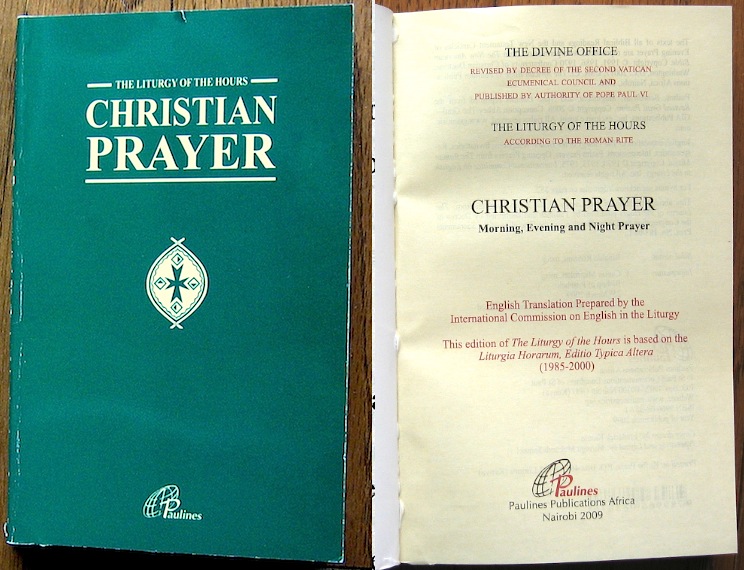 This is the smaller abridged edition for Morning, Evening and Night Prayer. It arrived just yesterday, taking two weeks to travel from Africa to Japan, which was sooner than I had expected. This breviary is 4 3/8 inches (11 cm) wide, 6 7/8 inches (17.4 cm) tall, and just over half an inch (1.5 cm) thick. 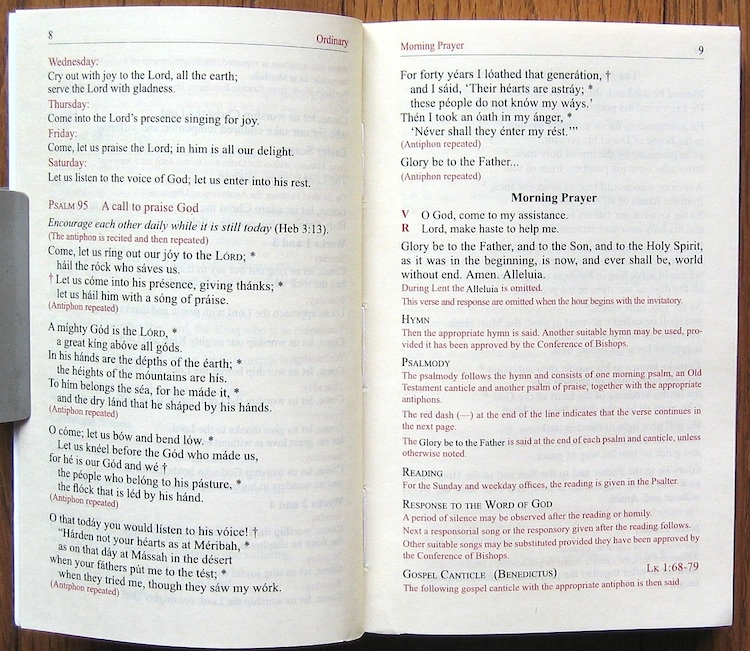 This is a paperback book that came with a clear vinyl cover for protection. I prefer the feel of the book itself, so I removed the vinyl cover (and put a tiny rip in the top edge of the front cover in the process). Since it is paperback, the pages will not lie flat, which explains the use of the clip in the photos. The binding is a hybrid type with the pages stitched together in signatures, and the signatures glued to the spine. 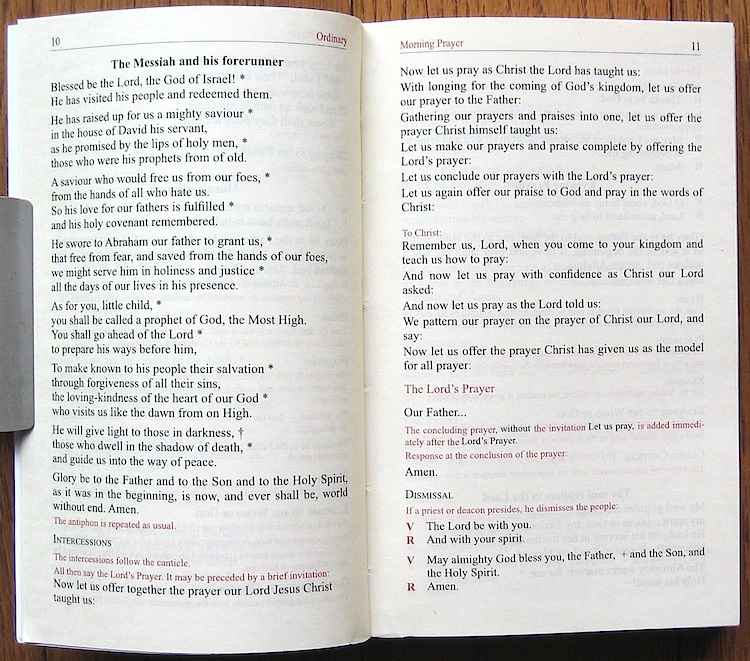 This edition has the four week psalter for Morning and Evening Prayer for Ordinary Time, plus Night Prayer. Morning and Evening Prayer are called the "two hinges" of the Liturgy of the Hours, and reflect the daily morning and evening sacrifice in the Temple in the Old Testament.  This abridged breviary is similar to Shorter Christian Prayer 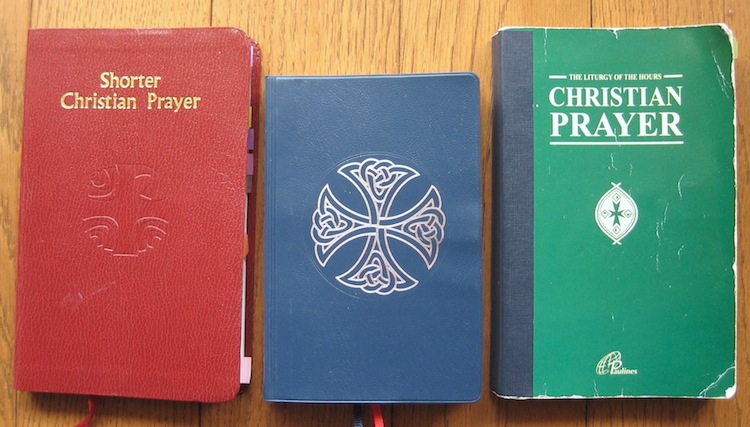 Shorter Christian Prayer, A Shorter Morning and Evening Prayer, and Christian Prayer (This photo was taken after a few years of usage, and shows signs of wear and repair) However, unlike these other two breviaries, the African Christian Prayer does not contain a Proper of Seasons or a Proper of Saints. In other words, there are no special days included, only the four-week Psalter for Morning and Evening of Ordinary Time plus Night Prayer. 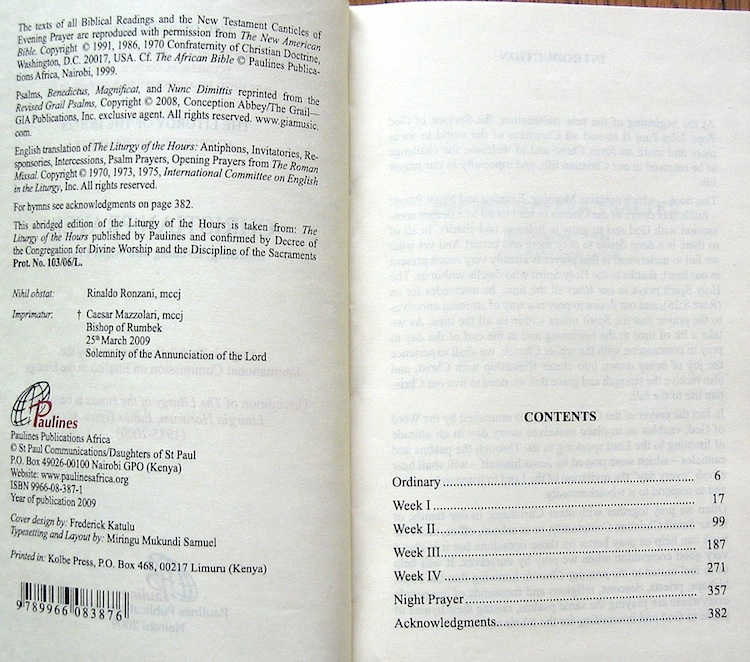 Granted, these other two editions don't contain the entire Proper of Seasons or Saints, but only selections which will allow for some variety during different seasons. Some people using this abbreviated African breviary might feel left out during other seasons and on solemnities, feasts and memorials, but this edition is apparently approved for use in Catholic parishes and communities in Africa, and from what I understand, this shorter "bare bones" arrangement is still considered the proper, official Liturgy of the Hours. Some folks will appreciate the simplicity with less need for page flipping. 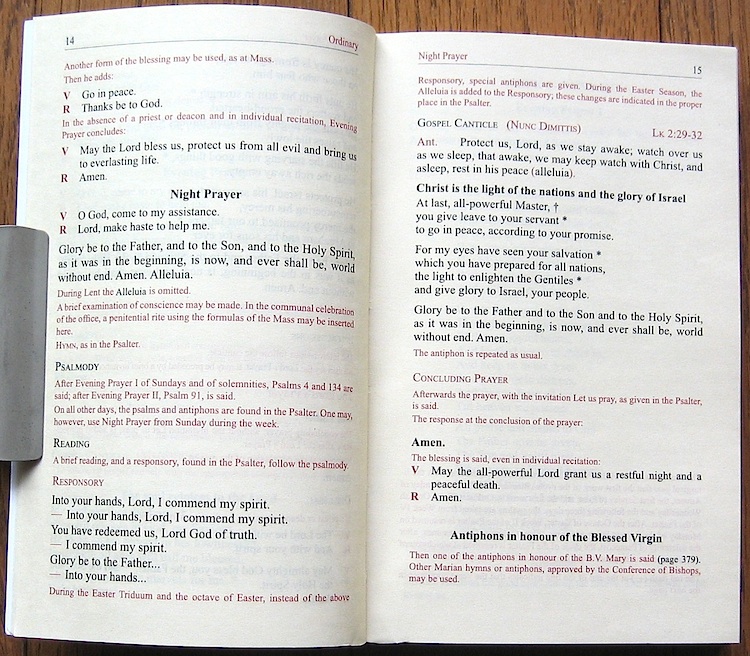 They chose to call this volume Christian Prayer rather than attach the descriptive Shorter to the title as the other breviary publishers have done. Aa small volume such as this will allow the lay person to respond to the challenge made by Pope Benedict: I would like to renew my call to everyone to pray the Psalms, to become accustomed to using the Liturgy of the Hours, Lauds, Vespers, and Compline. 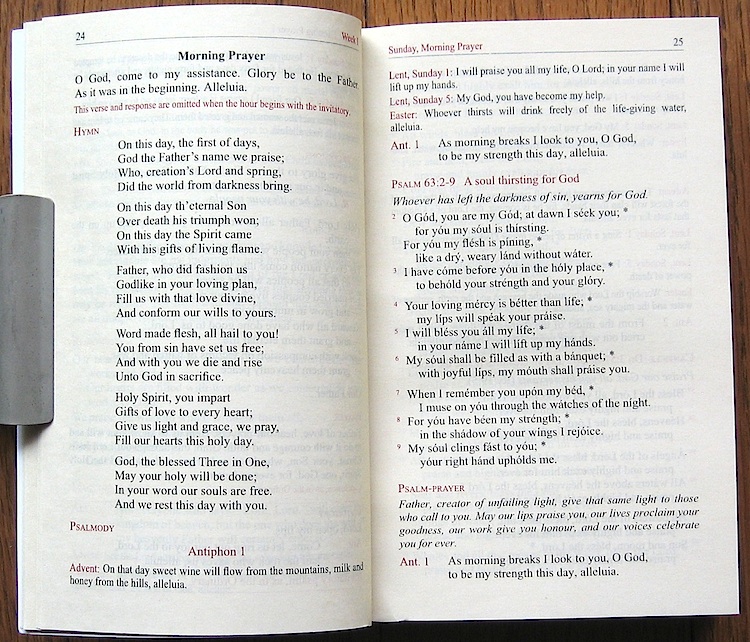 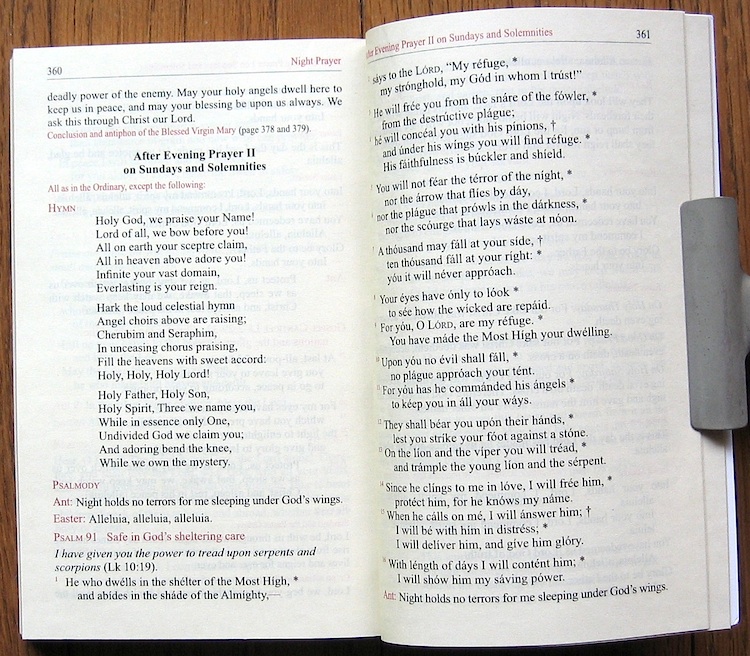 The Prayer of the Church (single volume) August 11, 2013: A year and three months after I bought Christian Prayer, I decided it was time to order the larger Prayer of the Church. The main reason was because I grew tired of using a paperback breviary, and it was starting to show signs of wear after constant use. 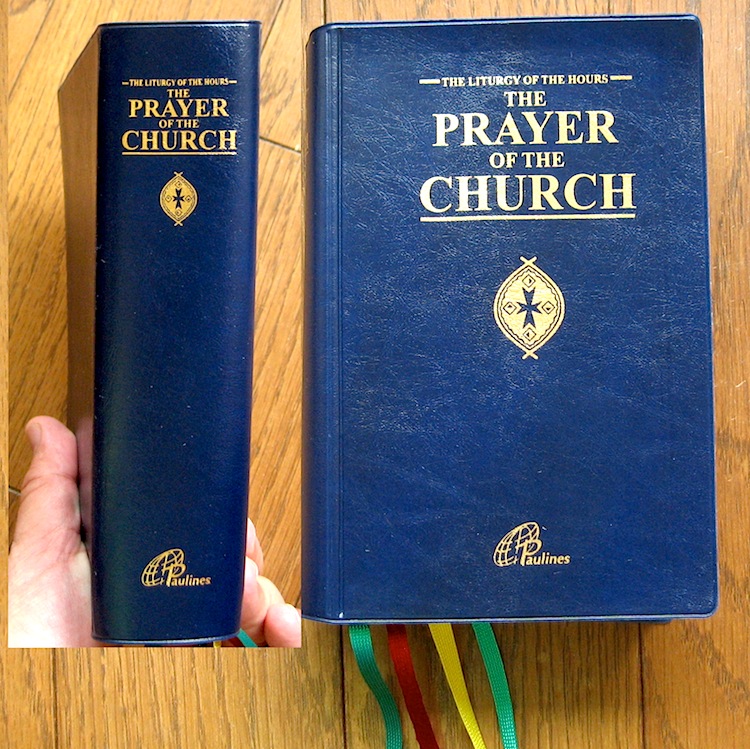 I really prefer nicely bound books -- preferably in leather -- but since that was not an option, I'm happy with this vinyl leather texture breviary. 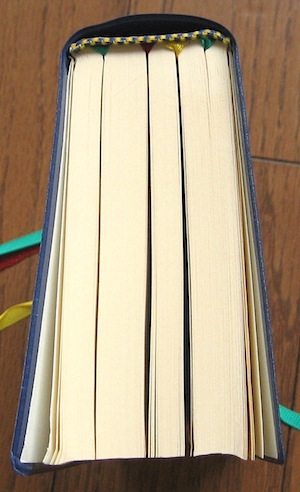 It is very similar to the American Liturgy of the Hours in look and feel and size. The binding is sewn so it lies flat, and it looks very well made. There are four ribbons plus four inserts. It was printed in Italy. 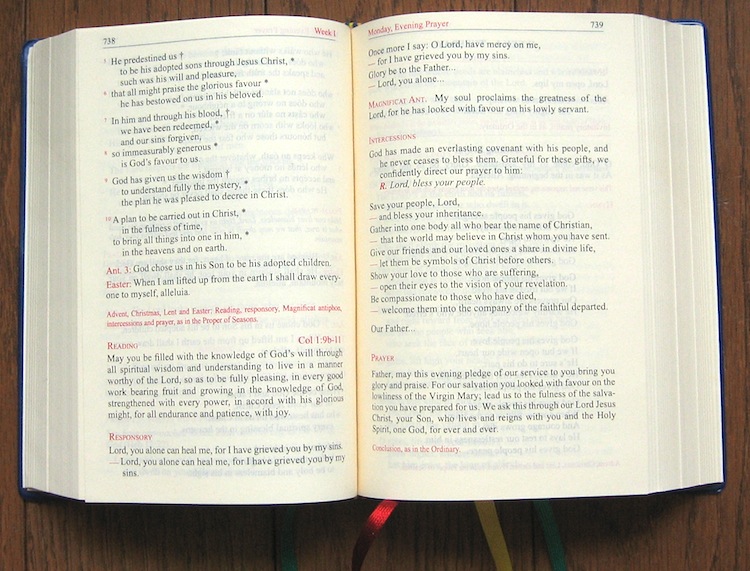 This book has the entire breviary for Morning Prayer, Daytime Prayer, Evening Prayer and Night Prayer. I love having all that in one volume. The U.S. one-volume Christian Prayer only has selections for Daytime Prayer but not for all four weeks. 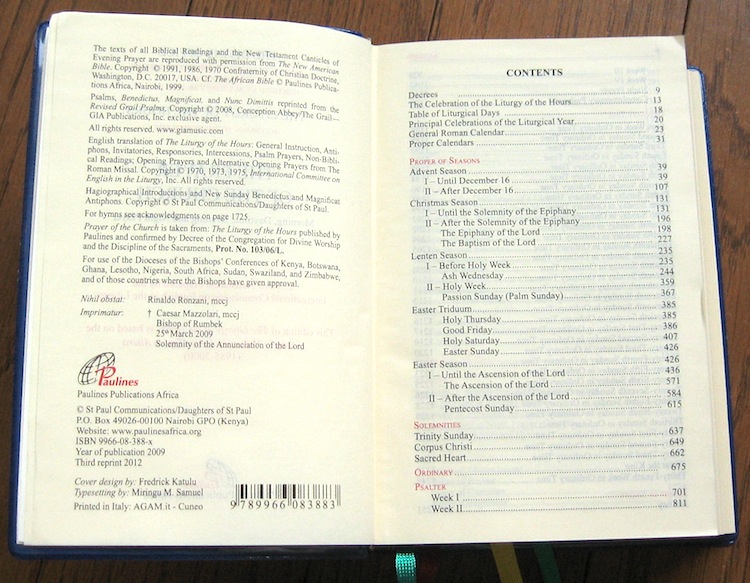 Only the Office of Readings is not included in this breviary because that would require four volumes instead of one. 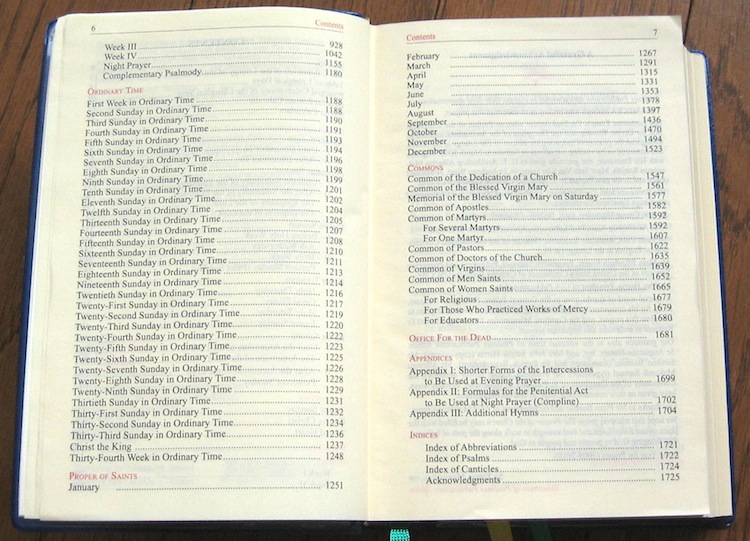 I took these photos minutes after it arrived in the mail before I had a chance to damage it with my clumsy hands. This time it took just over two weeks to travel from Kenya to Tokyo. I'm saving the cool postage stamps, too! This book is 4 1/2 inches (12 cm) wide, 7 inches (17.8 cm) tall and 1 5/8 inches thick (4.1 cm). If it were a paperback, it would be exactly the same height and width as Christian Prayer above because the paper block is the same size except in thickness. 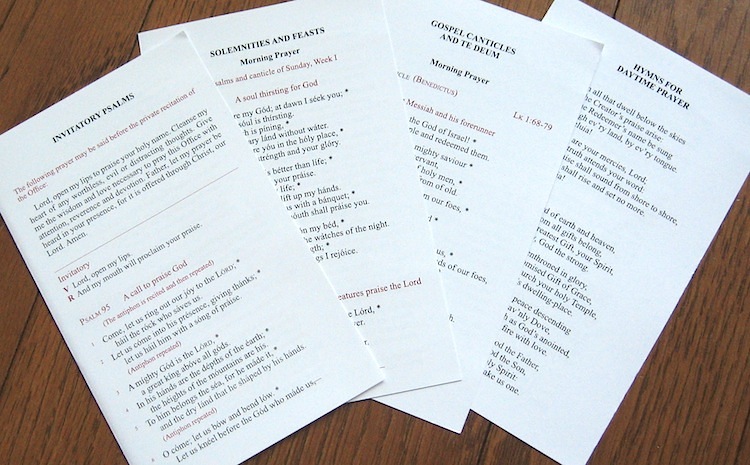 I like the fact that they chose to call this one The Prayer of the Church since that is exactly what my one-volume Japanese breviary is called -- except in Japanese, of course (KYOUKAI NO INORI). This breviary looks classy and feels very durable. I think it will last a very long time. I have written more about the Liturgy of the Hours in an article called The Prayer of the Church. The Liturgy of the Hours (four-volume set)
The main reason was because I had added the Office of Readings to my daily routine, and had been using the electronic version on my tablet for that Hour. In Japan where I live, there is the real possibility that a major earthquake may force me to move to an evacuation center (if I survive the quake). I don't want any part of my prayer life to depend on an electronic device which in turn depends on a battery which must be charged frequently. So I decided it was time to buy the four-volume set. I was also encouraged to move back to books by part of an address that Cardinal Sarah gave to the Roman Forum on Summorum Pontificum: Secondly, I must -- somehow -- manage to put aside, even if this must be temporary, the world and its constant demands. I cannot participate fully and fruitfully in the Sacred Liturgy if my focus is elsewhere. Perhaps it is very practical and convenient to pray the breviary with my own mobile phone or tablet or another electronic device, but it is not worthy: it desacralizes prayer. These apparatuses are not instruments consecrated and reserved to God, but we use them for God and also for profane things! Electronic devices must be turned off, or better still they can be left behind at home when we come to worship God. I have spoken previously of the unacceptability of taking photographs at the Sacred Liturgy, and of the particular scandal that this gives when it is done by clergy vested for liturgical service. We cannot focus on God if we are busy with something else. We cannot hear God speaking to us if we are already occupied communicating with someone else, or behaving as a photographer. 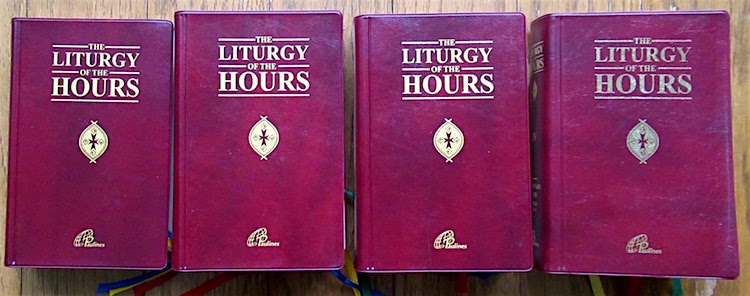 Despite the illusion to the contrary (caused by differences in book thickness), these books are all the same height and width I was tempted to buy the U.S. edition, but for the reasons mentioned at the beginning of this article -- including the desire to identify with solid, conservative African Catholics like Cardinal Sarah (although I don't know if his home diocese in Guinea uses this particular breviary), I decided to go with the African breviary for the four-volume set. This time around, the ordering process was simplified (so I thought) because you could order directly from the Paulines Africa web site. However, the web site would not let me register, so I had to contact them by e-mail to complete registration. Then the web site would not permit me to complete the credit card payment for the order, even though I attempted it several times (trying to ignore the warnings from my browser that this was not a secure site and that my sensitive information could be stolen by third party hackers).
The payment process took six days, and the books finally arrived in Tokyo twelve days after they were finally shipped, so the time from my first attempt to order until the books arrived was about two and a half weeks. The four-volume set costs $120.00 but with the shipping cost from Africa to Japan, and the processing cost of paying by card to the Paulines in Boston, the final amount was $190.48. But I still consider it a good investment (and I had received a monetary birthday gift which I used to pay for this). The ribbons varied in color and number with my set, and I imagine every set is lightly different. Three of the books had three ribbons, but volume two (the thickest volume) had four ribbons. They each had a red ribbon plus a combination made of yellow, green or blue. We have a nice ribbon shop in Tokyo, so I will get more ribbons and tape them to the spine inside the covers. I always trim my ribbons so that they extend about an inch from the far corner of the page. Two of the books needed no ribbon trimming while the ribbons on the other two were quite long. Also, as many people do, I melt the ends of new ribbons with a lighter so they don't fray, but these ribbons are not synthetic plastic type that will melt with a flame; instead they will burn. So I coated the ends with white craft glue (such as Elmers) because it dries tough and invisible, and gives your fingers something firm to grasp when turning pages. The ribbons in the photo already have the ends coated with this glue. These volumes are the same size as the one-volume The Prayer of the Church , and most of them are about the same thickness. Volume one is a bit thinner. The pages look exactly like the pages in the one-volume breviary, so I won't bore you with more photos of the inside pages. One big difference I have discovered to my surprise was the absence of Psalm prayers in the four-volume set. In the one-volume edition, the Psalm prayers are printed in italics, and are easily overlooked, which is a welcome feature for those who don't pray the Psalm prayers. But in the four-volume set, they are completely gone. The set came with the same inserts (frequently used canticles, etc) as the one-volume set. These books have vinyl covers which are plain and practical. I wish I could have gotten these with leather covers, gold edges and round corners, but those options are not available. And I am not so obsessed with their appearance that I would want to send these away to a professional re-binder for an overhaul. The photograph at the beginning of this article has all three editions in a line. This is a composite photo, and the photos were taken at different times when each of the volumes were brand new. The paperback Christian Prayer I bought five years ago is very worn now. I have covered it with book binding tape, so there is no reason to take a photo of it now, because it doesn't look the same. The one-volume The Prayer of the Church I bought four years ago is also well worn, and the gold lettering is completely worn off the cover. Speaking of covers, I decided to buy some black zipper covers for the four-volume set, but there are no covers specifically available for the Afriucan Liturgy of the Hours, so I took a chance on the covers that are available for the American set. I ordered them from the CFP Holy Angels Gift Shop web site since they have reasonable prices and shipping to Japan where I live. They fit perfectly! Of course, the artwork is from the American set, but I don't mind at all.
These are advertised as leather, but I don't think they are real leather. But they seem real tough all the same, so now I can toss my breviary into a backpack without worrying about damage. The bottom line -- literally, in this article -- is that the African Breviary although not perfect has a lot of those elements that the rest of the world has been waiting for, and it is available right now. It is a good investment because it will not suddenly become out of date when the rest of the world catches up -- hopefully in our life time, but who knows? |
|
| |